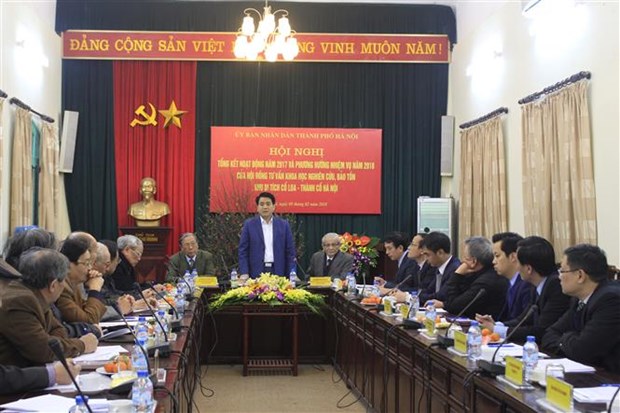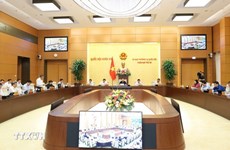Hanoi enhances preservation of Co Loa relic site
 Chairman of the municipal People’s Committee Nguyen Duc Chung speaks at a conference to review activities of the Co Loa – Hanoi Scientific Advisory Council in 2017 and launch its tasks this year (Photo: VNA)
Chairman of the municipal People’s Committee Nguyen Duc Chung speaks at a conference to review activities of the Co Loa – Hanoi Scientific Advisory Council in 2017 and launch its tasks this year (Photo: VNA)Hanoi (VNA) – Hanoi needs to accelerate the preservation and restoration of the ancient citadel of Hanoi and the Co Loa Citadel, said Chairman of the municipal People’s Committee Nguyen Duc Chung.
The official made the statement during a conference to review activities of the Co Loa – Hanoi Scientific Advisory Council in 2017 and launch its tasks this year held on February 8 by the Thang Long – Hanoi Heritage Conservation Centre.
In 2017, the council helped the centre expand excavation area east of the Kinh Thien Palace (the Thang Long Imperial Citadel) to more than 980 square metres. It also mapped out a plan on a spiritual tourism area in line with the preservation of Co Loa historical relic site.
Various exhibitions and educational programmes on Hanoi’s cultural heritage were also held last year by the centre.
At the event, participants discussed measures to enhance heritage preservation, focusing on management, land clearance and handover of exhibits, among others.
The Chairman of the municipal People’s Committee also asked the centre to cooperate with relevant agencies to supervise the handover of exhibits and seek counselling on preservation measures from domestic and foreign experts.
He also instructed the centre to accelerate the process of significant projects such as the restoration of the Kinh Thien Palace and the Co Loa Citadel, as well as the organisation of cultural events of the city and country.
Co Loa, the biggest
and most ancient citadel in Vietnam, was built by King An Duong Vuong between
214 and 208 BC as the capital of Au Lac, one of the earliest Vietnamese
kingdoms.
It is believed to be comprised of nine concentric
circles, yet only vestiges of three circles can be found at present. They
include an 8km exterior wall, a 6.5km polygon-shaped inner wall and a central
1.6km rectangular wall.-VNA













